In the bustling world of product packaging, efficiency and security are key factors. Today, we're going to explore the fascinating world of heat sealers, a vital player to enhance convenience, ensure product security, optimize efficiency, and guarantee consistent, reliable results.
Whether you're packaging food, electronic components, or small hardware parts, you'll discover why a heat sealer is a worthy investment for your packaging needs.
What are the Benefits of using a Heat Sealer?
From increasing convenience and efficiency to enhancing product security and reliability, heat sealers offer various advantages that could greatly impact your operations. Let's take a closer look at how this tool could revolutionize your packaging process.
- CONVENIENCE ― Heat sealers quickly and effectively join two layers of plastic material to create a permanent seal by melting (or welding) one layer of plastic to the other, most commonly heat sealers are used to provide poly bag closure. Heat sealers may also be used to seal poly sheeting and tubing, foil material, shrink films and poly coated kraft paper.
- EFFICIENCY ― Packaging equipment can significantly improve your efficiency, heat sealers are one of those pieces! They are an excellent investment for reducing packing time when closing poly bags by hand, and also allow you to make your own bags from poly tubing, reducing wastage and preventing oversized bags for your product. Customizing bags is especially cost effective if you require smaller quantities of many different sizes, as it eliminates the expense of stocking a variety of bag sizes.
- SECURITY ― Your product is more secure in a bag that has been heat sealed. Tampered heat-sealed bags are easily identified as damage is obvious, bags that have been stapled or tied can often be opened and reclosed without anyone detecting it happened.
- RELIABLE & CONSISTENT ― Heat sealers are quick and easy to set up, and when set correctly heat sealers provide consistent reliable seals.
How to Use A Heat Sealer
Impulse heat sealers simply plug into any 120v outlet, and are instantly ready for use, no warm–up time or cool down time is required.
Constant heat sealers also plug into a 120v outlet and very quickly reach the desired constant heat, a short cool down time is required.
To operate a heat sealer the bag or material is placed between the two jaws and with mechanical or automatic pressure, (depending on your sealer type), the jaws close.
The material is then welded (or melted) together as it is sandwiched between a jaw with a heat resistant rubber pad and a jaw with a heated element covered by a teflon strip.
- For constant heat sealers the heating element is always hot and the jaw should be closed and released appropriately to create the perfect seal.
- For impulse heat sealers heating elements are heated by a burst of electricity released when the jaw closes. The length of time the electricity is applied can be adjusted to suit the type and thickness of the material used.
Setting your heat sealer too low will result in an incomplete seal, setting it too high may result in making the material thin and weak, or even burning a hole through it.
Choosing the Best Heat Sealer
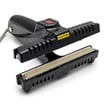

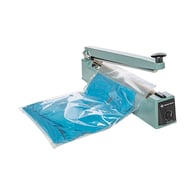
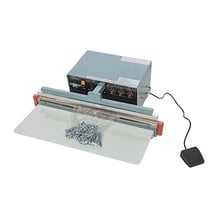
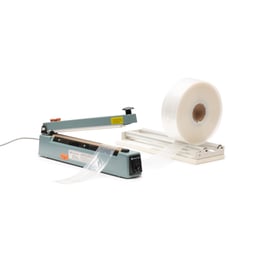
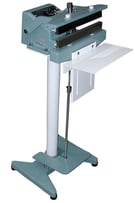
.jpeg?width=169&height=254&name=MM21210-605FIU%20Upper%20Jaw%20Seal%20(Foot).jpeg)
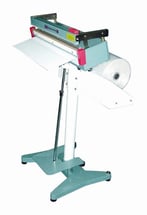
Handheld, Tabletop or Foot Operated
Here are a variety of types of heat sealers, including impulse and constant heat options and hand operated sealers that sit on a desk or packing bench, or foot operated sealers that stand on the floor.
Foot sealers are more efficient than tabletop sealers as they allow for hands free operation and therefore best suited for larger volume, while tabletop options are more suitable for the smaller user.
Thickness of the Element
Heat sealers also come with different element options, depending on the type or thickness of material you are sealing, and the product being sealed inside the material.
Liquids and heavier items require a thicker seal, this means you should look for a unit with a 5mm or even 10mm thickness seal so that your products are secure.
The location of the element is also variable, the most common is on the bottom jaw but upper jaw and dual jaw (upper & lower) options are available. Dual jaw is designed for thicker materials requiring more heat to weld the material together.
Seal Width
The width of the seal is also important, narrow bags are best used with a narrow sealer as they are much easier to operate. Common seal sizes begin around 8” wide and are available up to 40” wide.
With or Without Cutter
Sealers are available with and without cutters depending on if you’re sealing an open-end bag or creating & sealing a bag with tubing.
Standard or Automatic
There are also automatic sealers that can be programmed with automated sealing, these are excellent on assembly lines. If you have a production line that requires a fast seal, automatic sealers can be set to produce your desired number of seals per minute.
Constant Heat or Impulse Heat
Constant heat sealers take time to warm up, however, once at desired operating temperature they maintain a steady heat. They also offer higher melting points than impulse sealers as heat is kept consistently high, therefore a better option for thicker materials.
Impulse heat sealers are generally more popular than constant heat sealers. There are a few reasons for this, including the well-known facts that they are safer and more cost effective.
Impulse sealers have less chance of causing injury and have lower operating costs as high heat is only created when the sealing jaws are closed, while constant heat sealers the heating element remains hot until the electricity supply has been cut off. Impulse sealers also have the advantage that the cooling cycle can begin while the material is still compressed in the sealing jaws.
Purchasing & Maintaining Your Heat Sealer
When selecting packaging equipment, it is often best to trial a unit before making your final decision, it is important to ensure the tool or machine will be the most beneficial for your requirements.
At SmartShield we take pride in making our customers smile with packaging done right, therefore our sales team are happy to offer a free demonstration at your location.
Maintaining your heat sealer is important. Ensuring your heat sealer is set to the correct temperature will extend the life of the elements, take care to set the temperature just right, so it is neither too hot or too cold.
Setting the temperature too high can result in the material burning, keeping the temperature low enough to seal the bag efficiently without melting it will also preserve the Teflon fabric that protects your film from direct contact with the heated element.
Heat Sealers are used in the packaging process in many industries including manufacturers of small parts, hardware, automotive components, electronic components and food. The permanent seal provided by heat sealers keeps content fresh and prevents any unwanted elements coming in contact with the content.

